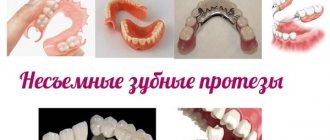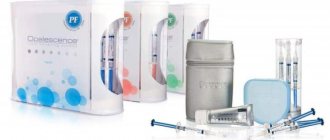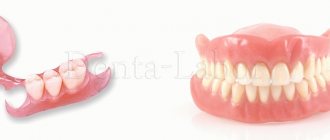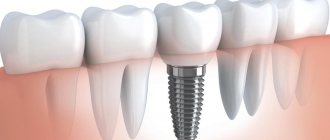Modern dental ceramics is a durable and beautiful material that is actively used in dentistry for the manufacture of various dentures: single dental crowns, inlays and onlays, bridges, removable dentures.
Metal-free ceramics are the most popular material for prosthetics when it is necessary to obtain a good aesthetic result. Therefore, this is the best option for making dentures for the front teeth.
The difference between metal-free crowns and metal-ceramic crowns, as is already clear from the name, is the absence of metal in the product, more precisely, a metal frame, the main problem of which is that when light of a certain frequency hits it, it begins to shine through the layers of ceramic covering it, worsening the aesthetics . In order for a metal-ceramic crown to look beautiful, more natural, a sufficient thickness of the ceramic veneer is required, so it is necessary to grind off a large amount of tissue from the natural dental crown, making the stumps of the supporting teeth smaller, but this method does not completely eliminate this annoying aesthetic drawback.
Prosthetic technology using metal-free ceramics makes it possible to produce crowns that cannot be distinguished from natural teeth, which is why this type of ceramic is recommended to public people. Since metal-free dental crowns do not contain metal, they are recommended for patients with allergies to metals.
An important advantage of metal-free frames is that they are thinner and lighter. This is achieved because frameworks, for example made of zirconium dioxide, are produced using high-precision milling cutters, while metal frameworks are still mostly produced using casting.
Below are the main technologies for the production of metal-free ceramics.
Types and main characteristics
The main division of bridges is based on material. Highlight:
- porcelain, which is relatively fragile and is rarely used for chewing surfaces;
- all-zirconium, characterized by high strength and long service life;
- crowns made on the basis of zirconium, but with ceramic coating (considered the most aesthetic, and at the same time very durable).
It’s difficult to say which option is the best. The choice must be made individually, and the client’s teeth must be under special control so that the best result can be achieved.
Pros and cons of metal-free crowns
The main advantage of the design is its high aesthetic characteristics. The fact is that the material has the same degree of light refraction as the enamel of a healthy tooth, so it is almost impossible to distinguish a dental crown from healthy chewing surfaces even with very careful examination.
In addition, crowns and dentures made of similar material have a high shock-absorbing capacity (which reduces the load on the periodontium and makes them indispensable for implant prosthetics), wear resistance, do not change their color, fit perfectly to the gums (and, as a result, prevent infection and caries development)
Until recently, crowns made of metal-free ceramic material were installed only on the front teeth to solve aesthetic problems, however, with the advent of new casting technologies, dental crowns and dentures using similar technologies are successfully used for dental prosthetics.
The disadvantages include the high cost of prostheses. Not only does the material that will serve as a replacement for extracted teeth cost more, but also the equipment to work with it and personnel trained to use the equipment. As a result, the cost of care and installation increases greatly.
Prices with installation in Moscow clinics
The cost of metal-free crowns is high, and also varies depending on the type of material, manufacturing technology, and pricing policy of the clinic. Therefore, it differs in different dentistry by 1.5-2 times. So:
- a crown made of E-max ceramics costs 17-30 thousand rubles;
- ceramic veneer – 17-22 thousand rubles;
- ceramic stump inlay - 14-19 thousand rubles;
- zirconium dioxide crown – 21-27 thousand rubles;
- zirconium crown on an implant – 25-45 thousand rubles.
Prices are given including turning, taking impressions and installation. The cost of preliminary treatment is calculated individually for each patient. Also, a number of clinics do not include temporary plastic crowns in their general price list - they will cost 800-1,500 rubles.
A crown made of zirconium dioxide will cost you up to 27,000 rubles.
Metal-free prostheses made of glass ceramics or zirconium dioxide are the best choice. But only when the patient has an unlimited budget. If paying 20 thousand rubles for a crown is expensive, you should take a closer look at metal-ceramic designs - they have worse aesthetic indicators, but the products will cost 4-10 thousand rubles.
Metal-free ceramics or metal ceramics
Unlike metal-ceramic crowns, where a metal cap is used as a base, followed by lining with ceramic mass, in a metal-free ceramic crown, aluminum or zirconium oxide is used as a frame, onto which ceramic mass is applied.
Another advantage of the design over metal-ceramics is its bioinertness, i.e. Completely harmless to the body and no allergic reactions.
Materials
- Zirconium oxide is the “white gold” in dental prosthetics. Indicated for those who have diseases of the kidneys, blood and hematopoietic organs, and the endocrine system. It is widely used for hip joint prosthetics, which has proven its biological compatibility with the human body and high strength properties. It has twice the fracture strength of aluminum oxide and allows the manufacture of three-unit bridges.
- Pressed ceramics - IPS Empress system. Contains leucite crystals, which increase its strength. However, this type of crown is best used for the front teeth. It has exceptional aesthetic properties.IPS e.max CAD is a lithium disilicate ceramic used for high-strength single restorations: veneers, inlays, crowns
How are crowns made?
To replace a tooth, you need to have a crown made in a medical clinic. To do this, there are three stages:
- the doctor, in the office, makes a cast of the jaw so that the position is clear, and transfers it to the laboratory;
- the equipment scans the impression and creates a model required for specific teeth;
- The implant is automatically made from the necessary materials.
Some clinics use more modern equipment to work with teeth. Which? An intraoral scanner, with which you can avoid using impression material, that is, skip the first step of working with teeth when making new bridges.
Our prices are a guarantee of high quality
Case pricing adopted in our Center may at first seem more expensive than in other clinics. But we use only high-quality materials and never purchase Chinese fakes. In addition, our system is honest - we indicate in advance all possible additional costs, do not hide anything, and do not put patients in an uncomfortable situation when drawing up the final estimate.
Levin Dmitry Valerievich
Chief physician, Ph.D.
What types of prostheses are there?
A similar approach in prosthetics is used as ceramic inlays and onlays (inlays, onlays), veneers (ceramic overlays on the front part of the tooth), dental crowns and dentures. Currently, in dentistry, prosthetics using ceramic products without metal are more often used in the manufacture of fixed dentures, however, in some cases, the technique can also be used in the manufacture of removable dentures (for example, when removable dentures are fixed using microimplants).
Group CL-I (powder/liquid)
These types of ceramics in dentistry consist of powdery and liquid materials. Their main component is silicon dioxide, which is contained in the glassy mass. Depending on the ratio of these components, the crown will have a more or less pronounced crystalline structure.
The CL-I group includes:
- Creation Porcelain, Jensen Dental;
- Ceramco 3, DENTSPLY International;
- EX-3, Kuraray Noritake Dental, Inc.
Dentures can also be made from feldspar, which contains barium, potassium, calcium or sodium. Initially, dental crowns were made from this material.
Options for aluminosilicates used:
- VITA VM 13, VITA Zahnfabrik;
- Vintage Halo, Shofu.
The production of prostheses of the CL-I group is carried out manually. They are used primarily for restorations that preserve most of the tooth, since the material is quite fragile and transparent. Nevertheless, it is feldspars that make it possible to achieve the best results when correcting the structure of a damaged crown.
Aluminosilicates are applied to the enamel in a thin layer of 0.2−0.3 mm. As a rule, ceramics from the CL-I group are used to restore incisors and canines, and less commonly, molars and premolars. Although the ceramic mass used for teeth is quite fragile, under adequate load the probability of its damage is very low.
Stages of prosthetics
Teeth can be replaced with crowns in a few simple steps. Among them:
- a thorough examination of the oral cavity by a doctor, assessing the teeth, determining which implant option is best suited;
- preparation in the form of caries removal, filling, removal of teeth that cannot be treated;
- treatment on the tooth, which will become the basis of the prosthesis;
- grinding, which will become the basis of one or several in the event that bridges can be made;
- making a cast;
- preparing the ideal implant from the right components, taking into account the characteristics of the patient and his requirements;
- if the prosthesis will take a long time to be made, a temporary crown will be installed on the treated teeth, which will protect the treatment area;
- After production, you need to try on the prosthesis and, if everything is satisfactory, the doctor inserts it into the oral cavity.
It is good if, after installation, the patient appears several times for a follow-up examination, to assess the condition of the materials and how they adhere to the teeth.
The entire procedure can take on average from several hours to a couple of days, and sometimes even a month. Much depends on what kind of help the tooth needs before prosthetics, what is the general condition of the oral cavity, and whether all the components and equipment necessary for making a crown are available. If quick production is not possible, there is no need to rush, since quality is important in this work and it is not cheap.
Advantages of the clinic
Reasonable prices for services
Highly qualified specialists
Modern techniques and equipment
Treatment on credit and in installments
Indications and contraindications for the use of metal-free ceramics
There are many indications for metal-free ceramic dentures to become teeth. They can be used if:
- a person is allergic to other materials, which does not allow for proper dental care and replacement;
- Canines or front incisors need to be restored;
- dark spots that cannot be removed;
- teeth require careful correction due to congenital defects;
- correction is required to obtain an even row;
- It is necessary to restore the teeth that are visible when you smile.
There are not so many contraindications for such dental care. These include acute diseases (after they subside, installation of an implant from any material is possible), pregnancy, and the habit of grinding teeth (bruxism).
The best thing is that there is no long recovery period required after the installation of dentures. The main thing is to learn the rules for proper care of new teeth and follow them carefully so that the dentures last a long time and do not cause any inconvenience.
Progress of treatment
Consultation and diagnosis
Drawing up a treatment plan
Treatment procedure
Preventive examination
Caring for metal-free dentures
There is nothing complicated about caring for teeth replaced with metal-free ceramic implants. The material is characterized by low capriciousness. It is worth following standard recommendations for hygienic care. It is important to avoid using paste with large particles, as they can scratch the denture. Also, you should not chew very hard foods with their help, as the prosthetic tooth may chip. After all, the density is, of course, high, but not infinite.
With proper care of teeth replaced with dentures, the latter will last 15 or even 20 years.
A solid period that fully justifies the rather high price. Sources:
- Accurate impression - Ryakhovsky A.N., Muradov M.A.
- Dental implantology. Introductory course - Kutsevlyak V.I., Grechko N.B.
- Dental implantation (surgical aspects) - Robustova T. G.
- Dental implantation. Success criteria - Zhusev A.I., Remov A.Yu.
Life time
The average service life of metal-free prostheses is 15 years. With proper care they will last longer. The timing depends on the chosen material and location in the dentition. It is of great importance how much the patient complies with the doctor’s instructions for the care of the structure and diet.
In our Center for Private Dentistry “Doctor Levin” there is a guarantee for the integrity and color of metal-free crowns made using digital technology for 25 years. Our orthopedists are confident in their work and the quality of the source material. The warranty periods are confirmed by digital passports for the products.











